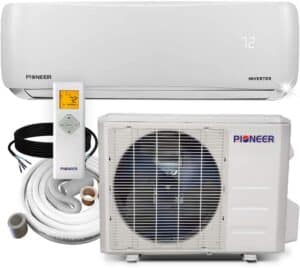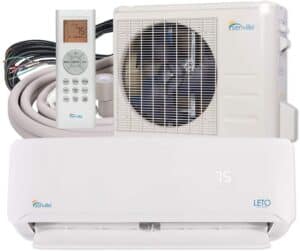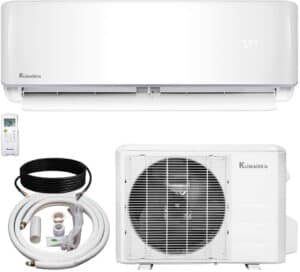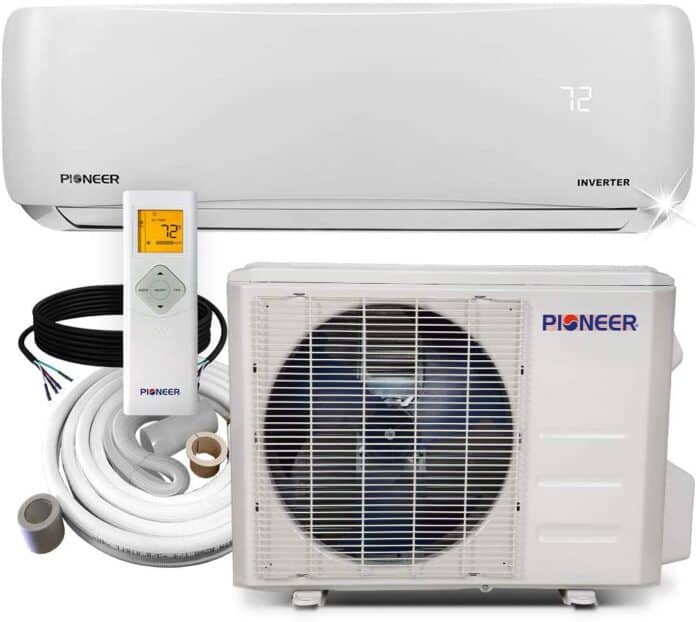Almost everyone would consider the highly sought-after and most efficient unit in terms of home heating systems.
And this seems to be why many want to install a ductless heating system, also referred to as the mini-split heating system. You’ll learn more about this type of air conditioner throughout the post.
Table of Contents
So, what is a ductless mini-split air conditioner?
A ductless or mini-split air conditioner, a mini-version of the split central air conditioner system. It is primarily composed of the following:
- an outdoor condenser that pumps cool air to the indoor components.
- An indoor unit that you could mount somewhere on the ceiling or wall releases the cool air into the house.
- A conduit connects the two, including refrigerant cooling tubes, a power cable, and a condensate drain.
A cooling unit works much like the central air with these components, yet it doesn’t require any ducts in the attic or wall.
So if you live in a home where ductwork is never done before, or you are willing to switch to a more energy-efficient cooling solution, this air conditioner is right for you.
Top 5 Best Ductless Mini-split Air Conditioners
1. Pioneer Mini Split WYS Series 19 SEER Air Conditioners
Number one bestsellers, not only on Amazon. The most recommended mini split air conditioners. Yes, those are Pioneer WYS series ACs. Available starting from 9000 BTU up to 36000 BTU versions with coverage between 200 – 1200 square feet. The system also can be used as a heater, dehumidifier, and ventilation. Pioneer uses the latest technologies making their ACs are super-efficient with a SEER rating between 16 – 19.5. Each model consists of 4 parts – ductless indoor unit, outdoor section, installation kit, and remote controller.
Pros
Cons
2. Senville SENL series Mini Split Air Conditioners 
Like Pioneer, also Senville provides various sizes of air conditioners starting from 900BTU (for bedrooms) up to 30000BTU (large rooms, garages). Senville SENL series Mini Split Air Conditioners are compact, affordable, efficient, and powerful as well. Each unit can also work as a heater, thanks to the integrated heat pump. Senville offers very high SEER – up to 19, making them one of the best in the class. In addition, this Air conditioner does not need expensive ductwork, making the installation process easier and less costly.
Pros
Cons
3. Della 12000-24000 BTU Ductless Mini Split Air Conditioners
Della offers six versions of ductless mini-split ACs starting at 12000 BTU up to 24 000. Della air conditioners come with smart technologies, including auto defrost, self-cleaning, timer, sleep mode, smart comfort, etc. Della also offers heating, dehumidification, and ventilation. One of the best features is to “follow my remote control.” The sensor in remote adjusts temperature based on your distance from the air conditioner.
Pros
Cons
4. MrCool Comfort 18000 BTU 19 SEER Ductless Mini Split Air conditioner
Already 3rd generation ductless mini-split by MrCool. It comes with a variety of features, the latest technologies, including Google assist and Amazon Alexa. This unit has improved efficiency ratings up to 19 SEER; it delivers high comfort and great performance. An air conditioner is designed to heat and cool up to 750 square feet large room.
Pros
Cons
5. Klimaire KSIV 19 SEER Ductless Mini-Split Air Conditioners
Klimaire KSIV series air conditioners are available with 9000 BTU up to 36000 BTU. The unit can also work as a heater, the dedicated dehumidifier; it has several fan speeds, including turbo function and sleep mode. The unit can clean itself and keep room temperature above 46 degrees F while not home during the heating season. The outdoor unit has an automatic defrost function.
Pros
Cons
How Does a Ductless Mini Split Air Conditioner Work?
This kind of air conditioner works like a regular air conditioner without ducts. Yes, it is possible. Here’s how a ductless mini-split air conditioner works. First, the indoor unit would blow warm air from your home over the cold evaporator coils. And so, the refrigerant that is running through these coils absorbs the heat and brings it now to the outside unit. Here, the refrigerant dumps all the heat that is pulled from the home’s air.
In a regular split system air conditioner, this indoor unit is in the closet or attic. Ducts would carry your home’s air to the central location, wherein it is cooled and returned to your home through more ducts.
However, in a mini-split ductless system, the smaller indoor unit is usually in the room that it is cooling.
The Advantages and Disadvantages of a Ductless Mini Split Air Conditioner
Of course, every unit has its pros and cons. For the main advantages of a mini-split system, consider the following:
Improved Heating and Cooling
If each air handler is put in a specific zone or room, it improves the areas’ cooling and heating. You can also control the temperature of these zones separately; at the same time, you’ll have the perfect living environment for adults, kids, and the elderly. With that, each could adjust the temperature of the area and enjoy the comfort of the home.
You could also switch off the air handler units of the rooms that are not in use. And also, you cool or heat only the desired zones at different temperatures as you wish.
No Need for Ducts
Since mini-split systems are ductless, they are indeed the perfect fit for heritage homes and buildings. In addition, it will not require you to install expensive ductwork to live in a temperature-controlled environment.
Flexibility in Placement
This is not the case with most add-ons. For example, you could install the air handler in the false ceiling, suspend it from the actual ceiling, or affix it on the sidewall based on the room’s aesthetics.
Better Energy Efficiency
This system offers more flexibility to homeowners about energy efficiency. And since this unit is ductless, there will be no scope of losing cool or warm air through leaks and cracks in the ducts. Also, the complete system doesn’t have to run in maintaining the temperature continuously.
Instead, there is just a need for you to turn on the rooms’ handlers, which are in use, and reduce the carbon footprint. Having limited use of power, savings would definitely be significant.
Easy to Install
Because there is no need for ductwork, the process of installation is indeed hassle-free. It is also less invasive since you only need an approximately three-inch hole to join the two units through a conduit.
On the contrary, here are some of the disadvantages of the ductless mini-split air conditioner:
Improper Placement Causing Short Cycling
Even if there is flexibility when installing the air handler, it still needs to be installed correctly to prevent short cycling. Again, you might need the aid of a trained or professional technician to work out the most suitable location.
Costly Installation
Installing this system or unit is indeed costly. However, it would be more expensive compared to installing the traditional split system. Most homeowners decline this system because of the expense.
Aesthetically Unappealing
Indeed, you cannot ignore the presence of the air handler. Though it is small, it’s still substantive in size and couldn’t be concealed and might spoil the beauty of your room.
You have to weigh down the advantages and disadvantages of this system so that you can decide whether it is the right unit to purchase and install.
What Are the Factors to Consider When Purchasing a Mini-Split Air Conditioner?
If you have an idea in mind to invest in a ductless mini-split air conditioner, few main factors must be kept in mind during your quest to make sure that you purchase only the best unit suitable for your needs. So, here are some of the most important factors to bear in mind:
Cost
Definitely, the cost is a critical consideration. Why? Well, that is because the cost of having this kind of air conditioner is also its main downside. So, if you are too tight when it comes to budget, think more than twice before investing in this one.
The most affordable models in this unit can cost up to $1000, and the higher-end units are about $5000. Expect to pay closer to the higher-end units if you want an air conditioner powerful enough to cool your large room or a multi-zone unit that could handle several rooms.
And if you want one which comes with a heat pump during winter, it would add another cost. Don’t forget that you also need to allot a budget for installation and the ongoing energy costs. Skilled individuals could install this unit, but most customers would still need to hire an HVAC specialist for aid.
Power or BTU Requirements
Since the air conditioner’s power is measured in BTU, note that if the BTU is high, the space to be cooled effectively is great. Therefore, you might see a certain room size that is provided in the specifications of the product. However, you might as well do the calculations according to the provided BTU information.
Number of Zones
You might find single-zone ductless air conditioners designed to cool only a room, and some multi-zone models can take on many rooms. And as expected, the cost would go up for every zone added, yet if you live in a house having several rooms, make sure you get an air conditioner with the right number of zones.
Voltage
Most ductless air conditioners would use the standard 110 to a 120-volt outlet. However, some larger models need a higher voltage. For a model that requires a 220 to 240-volt plug, consider the help of a professional electrician for an upgrade to make sure that you’ll not encounter any problem.
Certainly, this is a crucial factor that should be considered once shopping for the air conditioner unit. And if you want to save on installation costs, consider the type of volt outlet the unit needs.
Energy Efficiency
You should know that ductless air conditioners are Energy Star Certified, letting you have wide options to choose from regarding energy efficiency. If you plan to cool more rooms or large spaces, then the needed energy would also increase. So, the option of cooling a single space at any given time would help you keep the use of energy low.
Check out the SEER rating if you try to decide between energy efficiency and multiple models. Every unit would provide a rating in the specs and note that the higher the number is, the better the unit would perform overall energy use.
Durability
A ductless air conditioner can be considered a big investment; that’s why you might not want to deal with costly repairs or, even worse, wherein you need to replace the whole thing. Some units come with warranties letting you know that you can count on the product a lot longer or get it fixed only with minimal trouble and cost. You might also consider the reviews and the reputation of the brand to know more about the unit.
Ease of Installation
When installing ductless vents, it is recommended that you should consider a professional HVAC contractor. Some mini-split air conditioner manufacturers require professional installation for you to take advantage of the warranty. In addition, you can talk to local contractors about their experiences in installing different kinds of mini-split units.
Extra Features
For additional features that you should also consider, here are the following:
- Remote Control. Some units might come with remote control intended for greater convenience. You should definitely consider this feature.
- Additional Uses. Most mini-split air conditioners also include a heating feature, and some come with a dehumidifier function. Based on your location’s climate, it is wise to consider one that would provide heat during the winter months.
- Reusable Filters. We all know that filters could get expensive. So choose one that you can clean and reuse for you to save a lot of money.
- Programmable Timer. This could also help save money by making it a lot easier to set the air conditioner to keep the space to a certain temperature and at a certain time a day.
Placement Types
It is good to know that this unit offers many placement or installation options, and each offers advantages. You can even mix and match these placement types to suit your needs. Here are the options:
Wall Mounted Units
These are the most popular indoor units, which come with the widest options of energy efficiency ratings, sizes, and BTU configurations. Also, they are the simplest ones to install and the least expensive as well.
Usually, they are installed near the exterior wall ceiling requiring 3” drilling into the wall to be connected to the refrigerant lines, connecting wire, and drain tube. This unit must level against the straight and un-slanted wall.
If walls are too narrow or have high windows, or the walls are blocked with obstacles like furniture, you might require the alternate placement type.
Ceiling Cassette Units
These units are obviously installed in the ceiling and recessed behind a decorative grill, flush with the ceiling. However, the units offer an unobtrusive and sleek look. Typically, the BTU configuration of this unit ranges from 9000 to 48000.
These are ideal to be used in a T-Bar or on some other commercial ceilings. Still, they might also be installed in a traditional ceiling once there is enough space between the joists and above the visible ceiling vertically.
These units also need a clearance of 10” to 14” between the surface above and the visible ceiling. Finally, they often come along with a built-in drain pump, making it a lot simpler to remove the said unit’s condensation.
Concealed Duct Units
These units are a hybrid between the mini-split systems and central air systems. This one employs ductwork. The units are installed in an attic, a dropped ceiling, a closet, or a crawlspace. Ductwork will then be installed to carry the air to the target zone and via grille in the wall. The only visible element of this unit is the grill, and it could be customized to match the area’s look.
Also, this unit can supply two neighboring rooms with one unit by branching its ductwork. And take note that the temperature of the rooms will be controlled only by a thermostat.
LG Art Cool Units
You can consider this one as a stylish alternative to the traditional wall-mounted indoor units. These are units designed to mount as wall art via framing a photograph or painting with 20” x 20” size. The conditioned air flows out from the three sides of this unit to either heat or cools the room. This unit is stylish and also an unobtrusive AC choice, only under 5 inches thick. And these units are intended for multi-zone or single applications.
Are There Available Operation Options?
Here are some of the available operation options:
- Heating vs. Cooling. Once you have a heating system, the mini-split heating option is considered supplemental but not totally essential. However, you are offering air conditioning to your home, having no built-in heating. So, in this case, you might require a heat pump model. Sometimes, a basic single-zone mini-split system offers to cool only, but if you like both capabilities, you have to ensure that the model you choose includes HEAT PUMP.
- Low Ambient Operation. Once you require the special capability to cool to space with outdoor temperatures below 55 degrees Fahrenheit, you must choose a system with such operation.
How to Install the Mini-Split System?
So, how exactly is it to install the system successfully? Well, here’s the installation process:
Look for Professional HVAC Contractors
It is stated in the law that a licensed HVAC professional is the one required to install the mini-split system for you. Therefore, you need to do your due diligence to make sure that the technician you hire is definitely certified.
This mini-split system runs on pressurized and electrically charged materials that could be volatile once improperly handled. Also, a poorly performed installation could cause system underperformance and operational inefficiency over time.
And also, take note that manufacturers offer only parts warranties. The HVAC professional must provide the labor warranty, so check their warranty terms before dealing with them.
Consultation
Before installing the system, the HVAC contractor must schedule a consultation in your home to inspect the space’s layout and identify where to put the outdoor and indoor units. And it might also help to choose the desired placement types.
Time to Install
It could typically be completed for simpler installation within a day but could be longer based on the system’s size. You have to have a plan in advance along with your contractor.
Cost
And of course, there is a need for you to consider the cost of installing the system since the price could vary based on certain factors like the size of the unit, placement type, and unit capacity. Again, you can check with at least two or more HVAC contractors for comparison.
Are There Required and Optional Hardware for This Unit?
Since a mini-split system needs more than just the outdoor and indoor units to operate, additional components aren’t included in the system package. That’s why there is a need to purchase these components separately, or sometimes there might be provided by the contractor.
Condensate Lines and Drain Pumps
Like other AC units, the mini-split indoor units would absorb humidity, which condenses to the water and is then pumped away. These drain pipes are considered part of the tubing, which mini-split systems need to drain water down the piping to a receptacle like a bucket or a flower bed. And these pipes are supplied by the contractor often.
For those concealed duct units and high-mounted ceiling cassettes, the piping needs to travel upwards. But, of course, water couldn’t flow upwards alone, so the said models need a drain pump to pump the condensate away from the unit.
Some brands include a drain pump intended for these units. Or you may want to check such from your HVAC contractor on whether which pump to buy or not.
Refrigeration Line Sets
These circulate refrigerant in between the indoor and outdoor units. This line set has two semi-flexible insulated copper pipes – one larger and one smaller. This smaller pipe is the liquid line, and the larger one is the suction line. Line sets are being measured in feet, and they come in various lengths to accommodate several distances between the outdoor and indoor units.
Once buying these line sets, take note of the four factors – line set diameter measurements, distances between each indoor and outdoor unit, BTU configuration, and the number of rooms.
Ceiling Cassette Grills
These units require a grill to conduct the air coming from the hidden unit to the room its conditions. Manufacturers would always have the grill model to match the unit you buy.
Frequently Asked Questions
Q: Is there a need for home modifications for installation?
A: Installing this kind of unit is a relatively straightforward process. It would require modifications like three small inches holes in the walls the refrigerant tubing is run through. The holes could be drilled inconspicuously and might take up a lot of lesser space than a through-the-wall or window unit.
Q: Can mini-splits be painted?
A: It is not advised to paint the unit because this would void the given warranty.
Q: Can the system work in snow or rain?
A: Of course, yes. The outdoor compressor is intended to operate either in snow and rain.
Q: What is the usual mini-split system like?
A: The warranty would be separated into a parts warrantee offered by the manufacturer and the labor or service warrantee that the contractor would provide. The parts warranty would be divided into two separate terms for indoor and outdoor units in the manufacturer’s warranty. For example, indoor units might have 2-year warranties, and the outdoor unit offers five years and more. However, I always review the warranty before purchasing it.
Conclusion
Take note of the details above to know more about a ductless mini-split system before purchasing one. The above information would help you pick the right unit that will meet your needs and standards.


